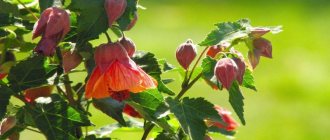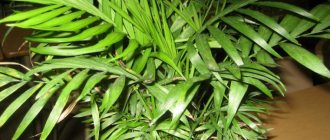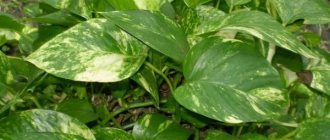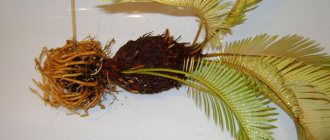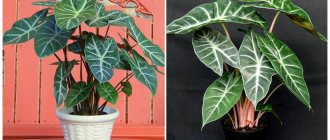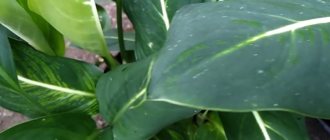Exakum (Exacum) is directly related to the Gentian family (Gentianaceae). This genus includes 30 species of not very tall plants. At home, only Exacum affine is grown, which is endemic to the island of Socotra, located in the Indian Ocean.
Exakum related is a herbaceous plant that branches quite strongly. It is a dense bush that reaches a height of approximately 30 centimeters. Succulent, erect shoots have short internodes. The short-petioled leaves are oppositely arranged and have a diamond shape with smooth edges. They reach 3.5 centimeters in length. On the surface of the green leaf, 1 central and 2 lateral veins are visible, which are colored in a lighter shade.
The plant blooms for 3–4 months from May to September. Small (diameter 15 millimeters) axillary flowers bloom at the tops of the stems. The flowers are very fragrant and the whole bush is covered with them. The flat corolla has a regular shape and consists of 5 petals that are almost round in shape. The petals can be painted in different colors depending on the variety, for example, “Blue Roccet”, “Midget Blue”, “Blue Eyes” are bluish, and “White Star”, “Midget White”, “Fu¬ji White” - snow-white. There are varieties with purple flowers. All varieties have thick, short anthers of rich yellow color.
What is exakum: description of the plant
Exakum is a biennial herbaceous flowering plant of compact size, which is classified as a member of the Gentian family. The height of the bush reaches 20–30 cm. The shape of the crown resembles a ball. The plant's root system is superficial and fibrous. The stems of the flower grow straight. The leaves are oval-shaped, rich green in color, with smooth edges. They grow 3.5 cm in length. They are placed on short petioles. Each leaf has 1–3 light veins. During flowering, the entire bush is covered with small flowers 1 cm in diameter, consisting of 5 lilac-blue petals and a yellow eye in the center.
They give off a delicate, pleasant aroma. The eastern and southern regions of Asia, the Malay Archipelago, and the island of Socotra are considered to be the birthplace of exakum. About 30 species are cultivated at home, most often Exacum related and Exacum three-veined. The plant is also found under the name Persian violet. At home, it is used to decorate rooms for various purposes, balconies, loggias, verandas.
Did you know? The Guinness Book of Records contains a record for creating the largest chandelier made from fresh flowers. It had a height of 17 m and a length of 10 m. 260 school and university students, gardeners, and park employees worked on its creation.
General information
- Under natural conditions, arctotis is a herbaceous plant or subshrub. Whitish, silvery pubescence is present on shoots with leaves.
- The leaf plates are arranged alternately or opposite each other. Inflorescences in the form of saucer-shaped baskets are five to eight centimeters in diameter.
- There are single flowers on long peduncles. They include ligulate pinkish, whitish, yellow flowers with tubular middle brownish flowers. Many scales are found in multi-row inflorescences.
- The fruit is brownish seeds and tufts. Seed germination lasts two years.
- This plant can be an annual, biennial or perennial. Perennial varieties grow as annuals in cold climates.
Varieties of Arctotis
Short-stemmed Arctotis
It is a perennial. This is a compact bush, its height is fifteen centimeters. South Africa is the homeland of this variety.
Whitish felt pubescence is present on the foliage with shoots. The flowers have a bright orange color and are reed-shaped and edge-shaped. Cultivation began in the early 19th century.
Rough Arctotis
It is forty to fifty cm in height. It grows as an annual in temperate latitudes. The basket-shaped inflorescences are 5 centimeters in diameter and consist of yellow tubular, yellow, reed-shaped flowers that have brownish streaks.
Stemless Arctotis
Perennial with a powerful rod-type rhizome. The pinnately dissected foliage is approximately 0.2 meters in length. On the outside they are green, on the inside they are whitish due to pubescence. The baskets are approximately 5 centimeters in diameter. They consist of yellow flowers with a purple lining of the reed type, black-reddish flowers of the tubular type.
Stechasolifolia arctotis
- It is a perennial, but in temperate climates it grows as an annual. The height of the green shoots of the erect type reaches one meter. They have pubescence, which is represented by a softish silvery pile. The leaves are dense and asymmetrical, they have a lanceolate shape with a wavy edge.
- They are located opposite each other and have felt-type pubescence. The upper rows of foliage are sessile, the lower rows of foliage are petiolate.
- Single inflorescences are on long peduncles. They have a faint pleasant odor, consist of snow-white flowers of the marginal type with yellow-golden bases and a light purple lower surface.
- The composition includes small tubular-shaped flowers, purple in color, in the middle of the baskets they have a blue-steel disk formed. If the day is cloudy, the inflorescences will close.
- Cultivation began in the 20th century. There is a species called grandis, which has long leaves with large baskets.
Hybrid arctotis
It combines complex hybrids that are very popular among gardeners. Such hybrids are obtained by crossing different plant species. They are grown as perennials and annuals because it depends on the climate of the area.
Gardeners rarely cultivate these varieties: eared arctotis with bright yellow reed-shaped flowers; lush arctotis, which has orange and rather large edge-shaped flowers; beautiful with bluish flowers.
The most popular varieties:
- Pink Sugar has yellowish colored flowers at the edges and pinkish ends to the middle.
- Mahogany with green tubular flowers.
- Hayley has deep yellow ligulate flowers with dark yellow, black cylindrical circles in the middle.
- Red Brick with reddish ray flowers, dark yellowish-brown centers.
They also cultivate the popular variety mixture Harlequin with varieties of different colors.
Conditions for growing indoors
Like most exotic plants, exacum loves light, warmth and high humidity. If you do not create optimal conditions for it in the house, it will significantly reduce its decorative value and the abundance of flowering.
Location and lighting
The flower pot should be placed in a well-lit place. The more light the bush receives, the more magnificent its flowering. The plant is not afraid of direct sunlight, so it can be grown on southern, western, eastern windowsills. Growing on the north side is undesirable for it; additional lighting is required here. During cultivation, it is advisable not to change the location of the flower and the light intensity, as this may negatively affect its appearance and flowering.
Temperature and humidity
The optimal temperature at which the flower feels good and develops is from +16°C to +20°C. It does not have a pronounced rest period, so there is no need to specifically lower the temperature for the winter. The lowest temperature a flower can withstand is +13°C. If the thermometer drops below, then the plant experiences defoliation and wilting. Temperature fluctuations and drafts are also detrimental to this indoor culture. In the summer heat, it is advisable to take the flower out into the open air. Exakum should be grown at high air humidity - above 60%.
Did you know? In 2022, the largest sculpture of fresh flowers was created in Ecuador. 564 thousand roses were used in its creation. It was made by 1.5 thousand local residents.
The impeccable beauty of Persian violets
Despite the fact that charming Persian violets are sold here as annuals, in fact these crops are full-fledged herbaceous biennials. They can also be grown as perennial crops, but, as a rule, after flowering, which continues throughout the summer and most of the fall, the plant simply dies, and if it blooms next year, it will only be very scanty, and it cannot be saved further. Typically, exakum blooms magnificently only in the second year, but the wait is completely worth it.
The unique flowers of this culture are simple, pretty, with a bright yellow eye. In addition to the luxurious, very dense foliage, they create the impression of an artificial miracle. Of all the living bouquets, exakum is one of the most spectacular crops. It can outshine floral arrangements of any complexity. This plant is not afraid of absolutely any surroundings; it loves additional decoration of pots and growing in containers with the most eye-catching design. In any setting and in any room, the Persian violet literally looks like a blooming miracle. And all the long months, while the exakum pleases with its flowers, it is literally impossible to take your eyes off it. It is quite easy to understand where this atmosphere-forming influence on the interior lies. Exakum is the very example of an impeccable combination of simplicity and elegance, nobility and harmony, the beauty of details without pretentious or flashy, too colorful elements that create an image of absolute impeccability. In order for the exakum to truly look impeccable, it will require appropriate care.
Exacum represents the Gentianaceae family, which is delightfully diverse, primarily in the beauty of its flowers and the richness of its blue palette. This plant can be found in Malaysia, South and East Asia; By origin, exacums can well be called eastern exotics. In the West, they are considered one of the most ancient cultures, known under the name German Violet. Despite the fact that among the exacums there are both annuals and perennial herbaceous plants, it is the short-lived species that have become widespread in indoor culture. These are compact crops, with fairly strong and thin erect shoots and a beautiful mass of lanceolate-heart-shaped leaves with a smooth edge. The flowers are collected in few-flowered clusters of inflorescences, flaunt a simple five-leaf shape with an unusual convex center and captivate with their scent and a rich selection of violet, blue and purple colors.
(…)Read more Exakum - the capricious Persian violet (1,915 words)
Permanent link to article | | Botanichka.ru, 2016. Article tags: Gentians, Persian violet, herbaceous plants, Exakum, Exakum related
Caring for a plant at home
Caring for exacum at home involves regular activities such as moistening the soil and air, applying fertilizers, and replanting. If necessary, treatments against diseases and harmful insects will be required.
Watering and fertilizing
Exakum loves well-moistened, but not flooded soil. The next watering should be carried out as soon as the top soil layer dries slightly. Over-watering should not be allowed, as this threatens the development of root rot. The optimal frequency of soil moisture is 2-3 times a week. In winter, the number and volume of watering should be reduced to once every 1–1.5 weeks. Watering should be done with warm tap water, standing for 1–2 days or passed through a filter that removes harmful impurities and chlorine.
In order to maintain the required level of air humidity, the bush must be regularly sprayed, kept on a tray with wet expanded clay or pebbles or near an aquarium, and an air humidifier installed. To achieve maximum decorativeness, the plant needs to be fed. The recommended frequency of fertilizing is once every 10–14 days. Any liquid universal fertilizer designed for indoor plants is suitable for feeding.
Important! Fertilizers need to be applied only during the growing season - from March to October. There is no need to fertilize at the end of autumn and winter; this will only harm the plant.
Trimming
No pruning is needed for this plant. Young shoots independently form a spherical crown. But in order for flowering to be as abundant as possible, it is necessary to promptly remove faded buds.
Transfer
Exacum is replanted in the spring. Since it does not grow for a long time, this procedure will have to be performed only 1-2 times. For exakum, you need to select a small pot with a diameter of 7–10 cm. It can be either plastic or ceramic of any configuration. Land for planting can be purchased ready-made in the store. Loose and light soil with good air and moisture permeability, with a slightly acidic or neutral pH level (from 5 to 7) is suitable.
You can also prepare it yourself using the following ingredients:
- turf land;
- leaf soil;
- leaf humus;
- peat;
- sand.
The transplant technology is as follows:
- Place a three-centimeter layer of drainage made of expanded clay, pebbles, clay shards or other materials at the bottom.
- Sprinkle a small layer of soil on top.
- Place the bush in the center of the pot.
- Fill the voids with soil so that 1.5–2 cm remains from the edge of the pot.
- Water the flower generously.
- If necessary, add a top layer of soil substrate after shrinkage.
You will be interested to know how to properly plant indoor flowers in a pot.
Flowering period
The first flowers appear in May. Flowering lasts until autumn. The flowers are formed so abundantly that sometimes neither leaves nor stems are visible behind them. The most luxuriant flowering is observed in the second year. After the buds of a biennial flower have faded, it is not advisable to keep it during the winter, since it will no longer be able to achieve the same decorative effect. You need to propagate the flower and grow young bushes.
Reproduction methods
Exakum is propagated in two ways: vegetative and seed. Both the first and second are easy to produce at home.
Seeds
Seeds and soil-peat soil for planting them can be purchased at a specialized store. Sowing is done in the fall. The moistened soil substrate should be poured into a long flat container. Pour the seeds onto its surface, distributing them evenly. Next, the container must be covered with glass and placed in a well-lit, warm place. The substrate is moistened as the top layer dries.
Every day, in order to ensure a flow of fresh air to the seedlings and prevent the development of fungal infections, the glass should be removed for 15–20 minutes. After the sprouts appear, after about 14–18 days, it is removed completely. As soon as the sprouts grow 4 leaves, they are planted in separate pots. Care for them in the same way as for adult plants.
Cuttings
Cuttings are cut in spring from strong, well-developed apical shoots. It is necessary to cut off shoots 8–10 cm long with 2–3 internodes. Cuttings are rooted in two ways. At first, they are placed in water, which is changed periodically. In the second case, the cuttings are placed in a damp substrate and covered with a plastic bottle. Roots should be expected after 2-3 weeks. After which the plants are transplanted into permanent pots. To get a very lush bush, you can plant 2-3 cuttings in one pot.
Biennial Miracles
Biennials usually live up to their name. The first year they gain green mass, and the second they delight with flowering, after which they scatter seeds and die. There are flowers that are cultivated as biennials, but can actually be grown for several years. In the third year, they bloom worse, grow less frequently, and sometimes even die during wintering.
This led to the division of biennials into true biennials and those that are grown as biennials, being perennials. The first group includes bellflower, lunaria and mallow. For the second - pansies, daisies, forget-me-nots and Turkish cloves. According to the time of their flowering, biennials are divided into spring and summer. Spring varieties include forget-me-not, daisy and pansy, summer varieties include night violet, foxglove, Turkish carnation, bellflower, lunaria and mallow. It is spring biennials that are especially valued by gardeners because they fill the niche between spring and summer flowers with their flowering.
Let's look at the main commonly used biennials that you can try to plant on your site and thereby revive its appearance.
Plant diseases and pests
If the plant is provided with the right conditions and proper care, it will not get sick. Pest attacks and disease damage are observed only in the case of incorrect cultivation techniques. So, if the plant is overwatered, it may suffer from root rot. The disease can be detected during transplantation or suspected in case of wilting of leaves, flowers, stems, or stunted growth. To heal the plant, you will need to transplant it into a new pot and soil.
The roots need to be inspected for rot, damaged ones should be removed, the cut areas should be dried with crushed activated carbon, and healthy specimens should be treated with any systemic fungicide. If most of the roots are damaged, you need to cut cuttings from the apical shoots and grow a young plant from them. Dispose of the old bush.
Important! When processing indoor plants, you should not forget about personal safety measures - carry out processing only in a well-ventilated place, protecting your body and face with special protective equipment. Consumption of food and drinks during processing is strictly prohibited.
Among the pests that can affect exakum are spider mites, aphids, and feltworms:
- Spider mite can be found on the lower leaf plate. During its life, it leaves cobwebs on the stems and leaves. When it infects a plant, the leaves become covered with brown spots, dry out and fall off. The mite starts when the flower grows in too dry and hot conditions. To prevent its occurrence, it is necessary to maintain high humidity. When a tick appears, you need to moisten the flower well and cover it with a bag. Among chemical agents, acaricides fight insects well. Medicines will do «Flumite", "Akarin", "Apollo", "Borneo", "Aktellik", "Fitoverm".
- Aphid lives on the lower leaf blade. This is a small sucking insect, measuring up to 1–2 mm. During its attacks, the leaves on the plant turn yellow and dry out. By drinking the juices from a flower, aphids can lead to its complete death. When you first detect the presence of insects, you need to treat the bush with a soap solution. If this method does not help, treatment with chemicals, for example, Fitoverm, Actellik, will be required.
- Feltworm, or mealybug, leaves behind white lumps on the soil and flower, similar to pieces of cotton wool. The fight against this insect is carried out by wiping the organs of the bush with a soap solution, infusions of garlic or tobacco. In case of mass destruction, they resort to the help of chemical agents “Aktary”, “Biotlina”, “Calypso”, “Confidora”, “Fitoverma”.
Thus, exakum is a beautiful and abundantly flowering indoor plant that has a short lifespan of 1–2 years. In order for it to delight with abundant and long flowering in summer and autumn, it needs to create favorable conditions and provide high-quality care for it.
